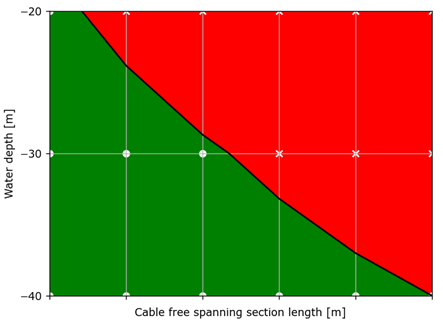RYDER is part of Tekmar Group plc.
At RYDER, we embody the principle of Deep Confidence in every aspect of our work, ensuring that our clients can trust in the reliability and safety of their offshore energy projects. This commitment is exemplified in our advanced approach to free spanning cable analysis using cloud technology.

Environmental conditions can lead to localised changes in seabed levels, exposing buried subsea power cables and resulting in unintended free spans. These free spanning cable sections pose a risk to operators, as the loading on the exposed cables can potentially lead to failure.
RYDER employs OrcaFlex to model free spanning cable sections. We assess cable loading under ultimate limit state (ULS) conditions against the cable’s mechanical limits. This is typically performed for a range of ULS return periods to provide an informed risk profile for wind farm operators.
To estimate the fatigue life of the free spanning cable section under operational conditions (fatigue limit state), we run OrcaFlex simulations for every combination of wave height, period, and direction from the site’s annual wave scatter data. Analytical models are then used to estimate span-wise fatigue damage and corresponding life for the cable’s critical components.
Fatigue due to vortex-induced vibration (VIV) is also assessed. We screen for significant VIV effects and perform a modal analysis of the cable response to both cross-flow and in-line loading.
Cable routings on a typical offshore wind farm site or lay corridor extend over a wide range of water depths and lay directions. With varying return periods and fatigue assessments, numerous free span cable model configurations may be required to comprehensively assess any given site.
RYDER utilises the benefits of large-scale automation provided by our cloud-based simulation data management system, qalx. This innovative system allows for the automation of large quantities of high-quality, traceable engineering simulations. By leveraging qalx, we can run thousands of simulations to develop a detailed risk profile for any site.

Through extensive automation with qalx, RYDER identifies the limiting analysis states (ULS, FLS, or VIV) and determines the maximum allowable free span length for each combination of cable type, lay direction, and water depth. This detailed analysis enables operators to identify the maximum length that a subsea cable free span can develop, along with an associated risk profile, at any location across the wind farm site.
By integrating advanced cloud technology and extensive simulations, RYDER ensures that operators can make informed decisions with Deep Confidence, enhancing the reliability and safety of their offshore wind projects.
MSc
Senior Analysis Engineer

Taiwan
Offshore wind in Taiwan is a booming sector, and Ryder are delighted to be involved.
East Java
Sitting near the boundary between the Sunda Plate and the Indo-Australian Plate, East Java presents numerous design challenges when considering permanent moorings, with complex soil patterns in a seismically active region.
Western Australia
Wave energy is a hugely undervalued resource, and Ryder are very proud to be involved in the sector, using our knowledge of the behaviour of piles subject to complex loading conditions to further the developments of foundation solutions.
Sarawak
The seabed off the northern coast of Borneo presents a fascinating geological sequence, influenced by huge paleo flows and slides which have changed the nature of the present-day seabed.
Zuluf Field
The Arabian Gulf remains at the forefront of oil and gas extraction with many fields still being developed and exploited.
West India
Design of two-stage drilled and grouted piles including driving analysis for casing, grouted connection design, lateral pile analysis and structural detailing
Faroe Islands
, Design of a drilled and grouted pile including grouted connection design, finite element analysis considering static and fatigue load cases.
Norwegian Fjords
Dropped object analysis, secondary protection design and PLAXIS slope stability analysis
Norwegian Fjords
Provision of detailed secondary protection design including rock volume estimates using GIS and PLAXIS 2D
South West UK
Site investigation management, survey management and FEED design for mooring anchors
US North-East Wind Cluster
Provision of subsea cable engineering including CBRAs, thermal performance, ground model management, SI specifications and permitting guidance.
US South-East
CBRA and development of location-specific anchor penetration modelling, optimising the burial depth
German Sector
Provision of subsea cable engineering including CBRAs, thermal performance, ground model management, and SI specifications
Polish Sector
Provision of subsea cable engineering including burial feasibility assessment, cable performance data and CBRA management
Provision of secondary protection analysis for CPS, LPA studies including optimisation
Taiwan
Subsea Cable Engineering, CBRA, seabed mobility studies, landfall assessment, construction support
Horsea Offshore Cluster
Subsea Cable Engineering, construction support, third-party review of CPS stabilisation
Outer Hebrides
Burial Assessment Studies, BAS for interconnectors between various islands in the Outer Hebrides